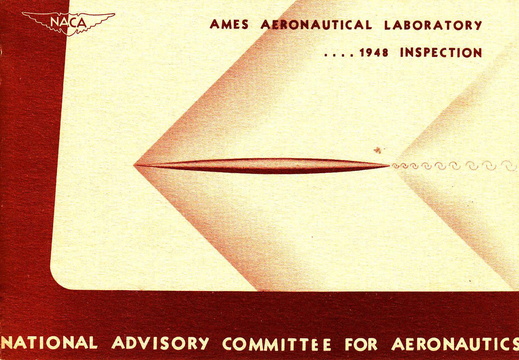
1948 AMES INSPECTION
The July 1948 Inspection at the Ames Laboratory highlighted the facility’s new wind tunnels and work on heat transfer and aircraft control systems.The second biennial Inspection at the Ames Aeronautical Laboratory was expanded to two days, on July 13 and 14, 1948. The program was identical both days, split to accommodate the 886 guests from aircraft manufacturers, airlines, universities, professional societies, Congress, local municipalities, the press, NACA headquarters and the other Laboratories, and the military services.
As with all the Ames Inspections, since there were no hotels nearby, blocks of rooms were reserved for the Inspection guests at the St. Francis Hotel in San Francisco and at the St. Claire Hotel in San Jose. Busses transported attendees the twenty miles to the Laboratory. Before they boarded their busses back to their hotels, the guests were invited to a happy hour at the Moffett Field Officer’s Club.
The event started with a moment of silence for George Lewis, Director of Aeronautical Research for the NACA for 30 years, who died the day before. The new NACA director of research, Hugh Dryden, reminded the attendees that the Inspection was meant to be a very general look at the aerodynamic work of the NACA, and that the NACA would accelerate the use of specialized conferences on focused topics. Special guest of honor, Jimmy Doolittle, was sworn in then as a new member of the NACA Main Committee. Chuck Yeager, who recently broke the sound barrier in the Bell X-1, attended to punctuate the role of the NACA in supersonic flight.
Jack Parson again organized the logistics of the events, and engineer Walter Vincenti honed the intellectual structure of the presentations. He presented a matrix of standard aircraft problems (performance, stability and control, and other problems related to engines and structures) mapped to speed regimes—subsonic, transonic and supersonic. Again, the emphasis was on the research facilities that Ames was still rapidly building, especially to tackle the problems of supersonic flight. Guests toured the new wind tunnels—the 16 foot, the 12 foot, the 40 by 80 foot, the 7 by 10 foot, the 6 by 6 supersonic, the 1 by 3 foot supersonic, the low-density wind tunnel, and the flight research hangar—and saw a special presentation on research on air induction. Ames highlighted its new work on heat transfer at high altitude, as well as its burgeoning agenda on the performance efficiencies of swept wings. Lunch cost $1.75, was served in the new flight research hangar, and the hangar floor was ringed with displays of new instruments and research techniques.
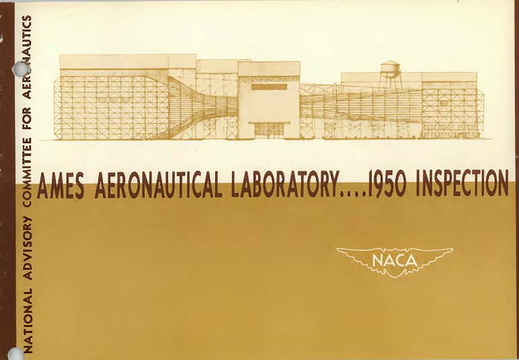
1950 AMES INSPECTION
The July 1950 biennial Inspection at the Ames Laboratory’s took place shortly after the onset of the Korean War and signaled the beginning of the NACA’s transition into missile and rocket research.
The 1950 biennial Inspection of the Ames Aeronautical Laboratory was held on July 10 to 12. Identical programs were planned for each of the 3 days. On the 12th, most of the guests were students in the military academies and, on July 13, Ames employees were invited tour the facilities and see the presentations. A public open house planned for July 16th was cancelled because of the “international situation.” Two weeks before, on June 27, the United Nations launched a police action in response to the invasion of South Korea by troops from the North. Last-minute cancellations reduced total registrations at the Inspection to 666 guests. NACA chairman Jerome Hunsaker opened the Inspection by noting: “even though we are a civilian agency of the Government, we are much concerned with national security.”
Russell Robinson organized the flow of the presentations: “Our product is not aircraft, engines, or missiles, not even experimental or research aircraft, engines or missiles. NACA uses these but only as a means to an end…the research job is not finished until the results are analyzed, a satisfactory explanation obtained regarding the controlling factors, conclusions drawn that will assist designers in general, and the whole accurately reported.” Technical papers useful to any and all aircraft designers, as summarized in the Inspection presentations, were the product of the NACA.
Although the speeches were still presented in 10 of Ames’ most prominent facilities, some of which operated during the talks, the speeches focused on research topics rather than the facilities themselves. Topics focused on the problems of supersonic flight: high-speed research on high-speed wings, low-speed research on high-speed wings, airfoil and body interactions, propellers, air inlets, dynamic stability, aeroelasticity and loads, buffeting, and research at high supersonic speeds and at higher supersonic speeds (meaning missiles at hypersonic speeds). The star at this Inspection was Ames’ new supersonic free-flight tunnel, designed by Harvey Allen’s branch to reach low hypersonic speeds, and Ames researchers formally addressed how they expected to someday open up flight in the hypersonic regime.
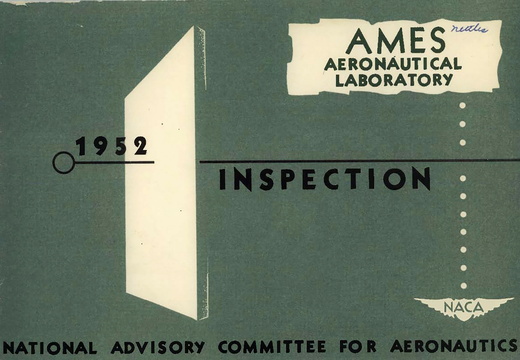
1952 AMES INSPECTION
The 4th biennial Inspection of the Ames laboratory was held on July 14 and 15, 1952. As before, the program was identical both days so that the 785 guests could be divided into manageable halves. The Langley and Lewis Laboratories, as well as NACA headquarters, each sent one DC-3 with about a dozen researchers to the Ames Inspection. The Sunday afternoon before, there was a private party to mark the 30th anniversary of Smith DeFrance’s service to the NACA. After the Inspection, the Main Committee members travelled to southern California to visit the High-Speed Flight Research Station and the Naval Air Missile Test Center at Point Mugu. Others went to Los Angeles for meetings of the Institute of Aeronautical Sciences.
This was one of the first Inspections where the NACA talked openly about security restrictions on its presentations, leading them to be less technical. They tracked who was an American citizen; the 1955 Inspection would be restricted to American citizens. Ames researchers began to see as more important, in both size and seriousness, their technical conferences. Examples of these included the conferences on Supersonic Aerodynamics in February 1950, on Aerodynamic Design Problems of Supersonic Guided Missiles in October 1951, and on the Aerodynamics of High Speed Aircraft in July 1953. These conferences had all the practice and polish of the Inspections, but with a more expert audience. Jack Boyd joined the NACA in 1947, but by the 1950 conference on Supersonic Aerodynamics had already been tasked to present work done in the 6- by 6-foot supersonic tunnel. Sitting in the front row were luminaries such as Hans Liepman, Tsien Hsue-Shen, Theodore von Karman. When Boyd expressed nervousness at addressing such an esteemed audience, von Karman, in his thick accent, assured him: “Young man, I assure you that you know more about your subject than we do.”
This 1952 Inspection, and those following, took on a more public-relations tone. Still, the Inspection was a great way to display how all the research work at Ames was interconnected, and thus supported the totality of American aerospace. Victor Stevens shaped the intellectual structure of the presentations. In addition to a booklet summarizing the presentations, he also prepared a booklet of the slides that were shown, with space for taking notes. Presentation topics included aeronautical loads, landing, static stability, automatic stability, missile dynamics, model construction, propellers and helicopters, higher speeds and longer range, research airplanes, and aerodynamic friction and heating. Wherever possible, Ames highlighted its capabilities in hypersonic research. The NACA issued three press releases to highlight its most timely research. One focused on aerodynamic heating and the 1600° F rise along the skin of missiles flying at Mach 5. Another release summarized a technical presentation on the prospects of boundary layer control to improve landing performance on supersonic wings. It was also at this Inspection that the NACA issued a press release on plans for the Unitary Plan Wind Tunnels.
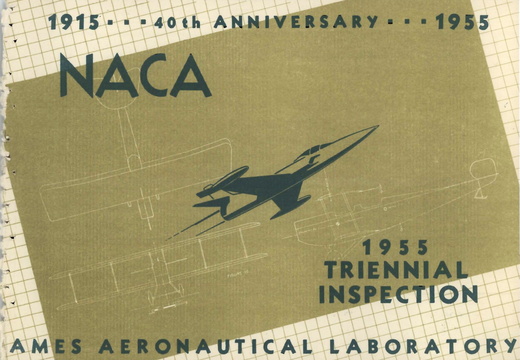
1955 AMES INSPECTION
The talks at the June 1955 Inspection of the Ames Laboratory revealed that the more advanced aircraft of the future required the same type of NACA research as previous generations.
Ames hosted a triennial inspection on June 27 and 28, 1955. The dates were selected to follow the joint meetings in Los Angeles of the Institute of the Aeronautical Sciences and the Royal Aeronautical Society. It was the 40th anniversary of the NACA, and guests were given a history booklet written by Jerome Hunsaker. He prepared it for the NACA anniversary dinner held on April 14, 1955 at the Smithsonian Institution, at which U.S. Supreme Court Chief Justice Earl Warren presented Hunsaker with the Langley Medal.
By 1955, supersonic aircraft were entering military service, and NACA work to solve problems associated with them dominated the meeting. Carlton Bioletti defined the intellectual structure of the Inspection, and quoted Hugh Dryden: “Many of the major problems of the aircraft of the future are old problems in new dress.” Designing sleek new aircraft able to fly at supersonic speed re-introduced old problems like buffeting, damping, and stability (and how the pilot can control those) as well as weight distribution and landing performance.
Furthermore, the number of test facilities at Ames was expanding rapidly, leaving Bioletti choices on where to host the topical presentations. Some presentations addressed new topics in old facilities: a session on static stability was presented in the 6- by 6-foot supersonic wind tunnel, on dynamic stability in the 7- by 10-foot wind tunnel, on airplane Flexibility (meaning wing loads and bending) in the airplane hangar, and on take-off and landing in the 40- by 80-foot wind tunnel. Some were presented in new facilities. A talk on the role of Flight simulators aided by analog computers was done in the flight research hangar, where a YF-86D aircraft was hooked up to a separate cockpit model. As a result, lunch was moved from the hangar to the sheet metal shop.
A presentation on hypersonic research, accompanied by a press release, on work at Ames on the reentry heating problem, was done in the new heat transfer tunnel (a precursor to the arc jet). A presentation on transonic research was done in the 14-foot transonic wind tunnel, which had recently been converted from the 16-foot tunnel, accompanied by a press release on the performance of the tunnel. The Unitary Plan wind tunnels, at Ames as well as Cleveland and Langley, had just begun operating. There was one session in the Ames Unitary Plan to inform the potential users on the capabilities of those tunnels, and also a session on jet aircraft crash and fire survival.
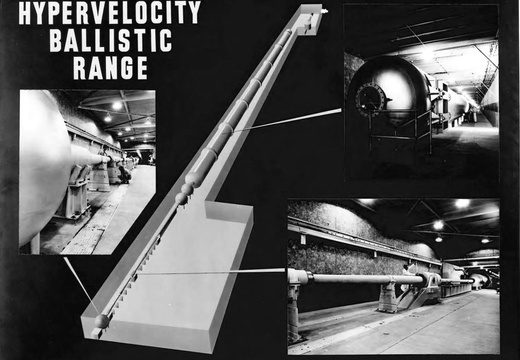
1958 AMES INSPECTION
The July 1958 Inspection at Ames was both the laboratory’s final Inspection and the final Inspection of the NACA era.
Ames hosted its last Inspection on July 14 and 15, 1958. Again, the dates were selected to follow the meetings of the Institute of Aeronautical Sciences in Los Angeles. Even at the time, Ames people suspected it would their last. The NACA was being absorbed into a new agency, the National Aeronautics and Space Administration (NASA), which portended a different relationship between Ames and the aerospace industry. The NACA Executive Committee held a regular meeting at Ames during the Inspection, during which they discussed plans to be absorbed into NASA. Furthermore, specialized NACA technical conferences, like one in March 1958 on High Speed Aerodynamics, showed that no general one-day Inspection could satisfy the increasingly focused interests of American aerospace leaders. NACA Director Hugh Dryden, in his introduction, noted guests would hear nothing about the X-15 airplane or aircraft operating problems because those were the subjects of future NACA technical conferences.
Of the nine presentation topics, eight addressed issues in spaceflight. The sole presentation on atmospheric flight dealt with a military topic: how to extend the range of supersonic turbojet bombers (noting it could someday carry civilian passengers). In a photograph from that presentation you can see a tunnel model of the sleek aircraft wing—following the theoretical work of Robert T. Jones and designed by Elliott Katzen—that inspired the red wing of the forthcoming NASA meatball logo.
Harvey Allen’s work on the blunt body had been declassified the previous fall. His theory, and the test facilities Ames built to validate it, took a starring role at the Inspection. In his introduction to the Inspection pamphlet, NACA Chair Jimmy Doolittle noted: “More than six years ago in this Laboratory an NACA scientist worked out the principle of the high-drag blunt nose cone to reduce to a minimum the aerodynamic heating experienced by a body entering Earth’s atmosphere at high speed. All current ICBM and IRBM warheads employ this concept. From this and even earlier beginnings NACA’s work in space technology has grown in orderly fashion until it now receives half of our research attention.”
Manley J. Hood structured the presentations. A presentation on the uses and orbits of Earth satellites (information useful in the International Geophysical Year satellites) was done in the 40- by 80-foot wind tunnel. A presentation on aerophysics (the chemical composition of air in the upper atmosphere) was done in the hypervelocity air ?ow apparatus, and a presentation on aerodynamic heating was done near the low-density and heat transfer tunnels. A presentation on entry research techniques
was done at the new Ames atmosphere entry simulator, one on piloting problems during entry was done in the flight research laboratory, and one on stability during atmosphere entry was done in the supersonic free-flight tunnel. Engineers from Langley discussed the X-7 rocket booster program for flight research on spacecraft in the Ames 11- by 11-foot transonic tunnel, and engineers from Lewis presented on electrical and nuclear space propulsion systems in the 6- by 6-foot supersonic wind tunnel.